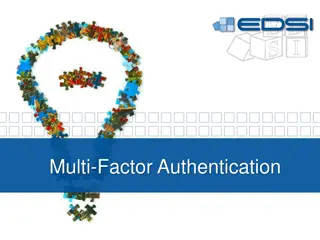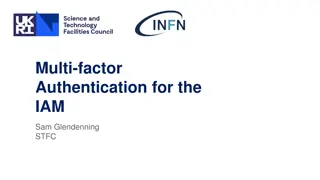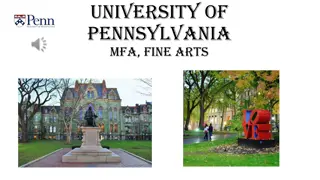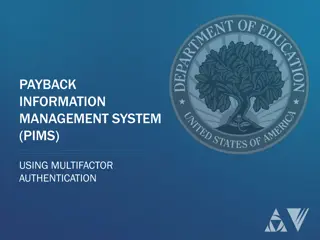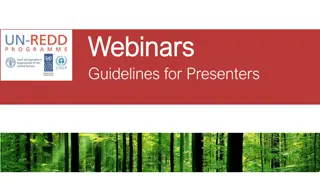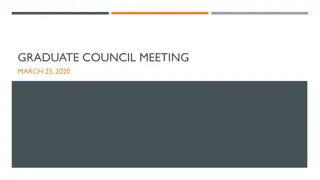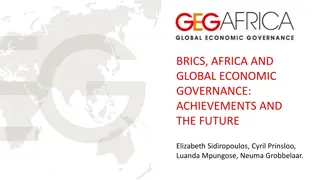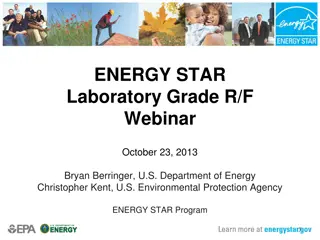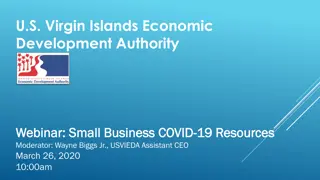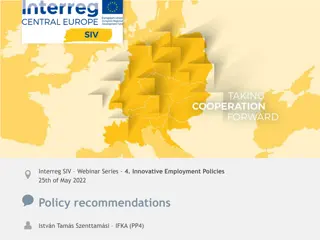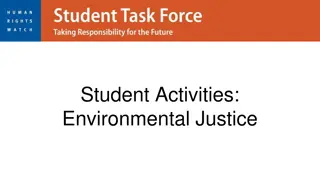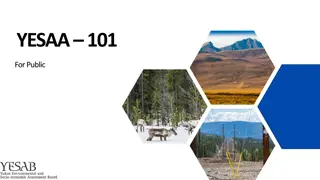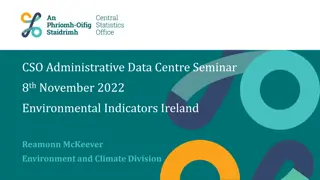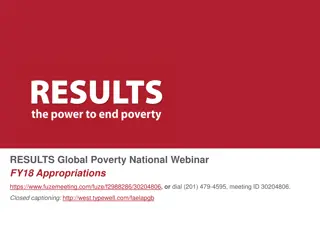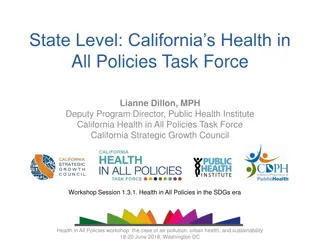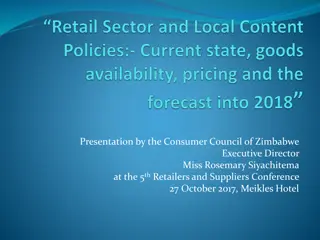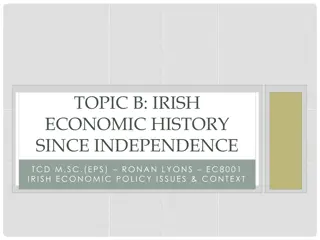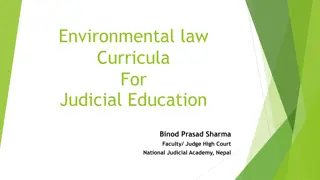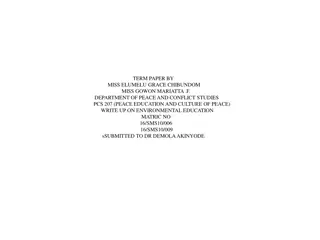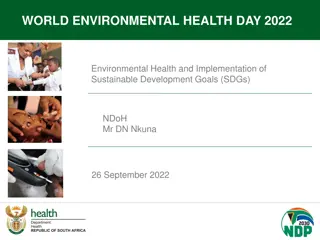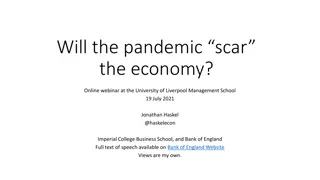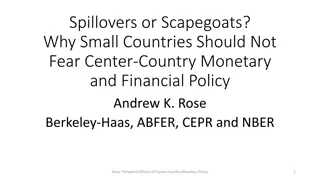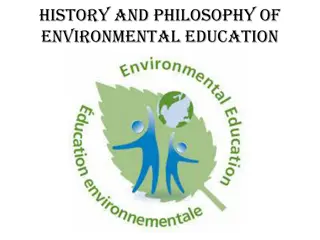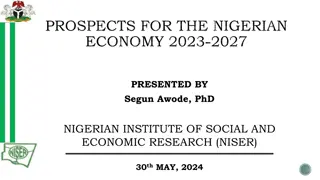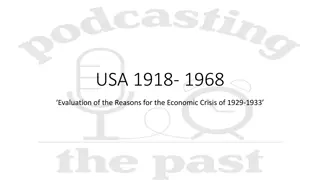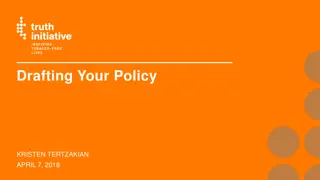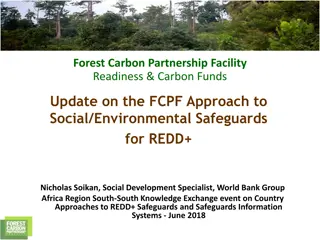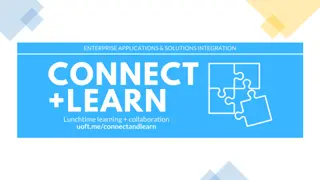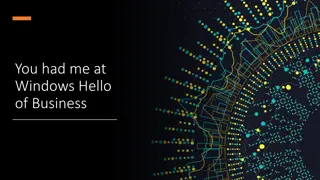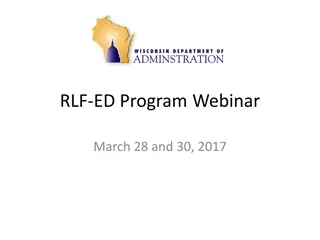Global MFA Manual Collaboration Webinar: Enhancing Environmental and Economic Policies
Discussing the collaboration between the Philippines, Laos, and ONS for the Global MFA Manual to improve material flow accounts, address environmental impacts, and support sustainable economic policies. Experts present on the purpose of material flow accounts, linkage to SDGs, and significance of sustainability policies in Asian countries.
Download Presentation

Please find below an Image/Link to download the presentation.
The content on the website is provided AS IS for your information and personal use only. It may not be sold, licensed, or shared on other websites without obtaining consent from the author. Download presentation by click this link. If you encounter any issues during the download, it is possible that the publisher has removed the file from their server.
E N D
Presentation Transcript
Webinar 1 ONS collaboration with the Philippines and Laos for Global MFA Manual Jim West, Heinz Schandl and Alessio Miatto 6 November 2017 LAND AND WATER
Welcome and introduction of webinar and participants
CONTENT OF WEBINAR 1 Summary of the purpose and use of material flow accounts Brief background of the manual, the linkage to the SDGs, and how this relates to the planned pilot testing An overview of the structure of material flow accounts focussing on domestic extraction
STYLE OF DELIVERY Short presentations by MFA experts Heinz Schandl, Jim West and Alessio Miatto and interactive parts where we ask you for input and feedback Presentation title | Presenter name 4 |
WEBINAR PARTICIPANTS Vivian R. Ilarina, Virginia M. Bathan, Faith Cabrera and Paolo de Jesus of Office of National Statistics of the Philippines Mr. Daovong Phomphakdy, Ms. Khounthavian, Mr. Vilaysy of the MONRE Data Center (NREIC) Presentation title | Presenter name 5 |
Introduction to MFA accounts, the Manual, its Purpose and the Engagement with ONS Presentation title | Presenter name 6 |
EVIDENCE BASED ENVIRONMENTAL (AND ECONOMIC) POLICY Environmental pressures and impacts are unintended consequences of modern systems of production and consumption Asian developing countries dual objectives increasing well-being and material standards of living while conserving resources and reducing waste and emissions Supply security focus: food, energy, water, fuel, metals Sustainability policy issues are complex and often contested Long-time horizons and high levels of uncertainty Require concerted policy effort to manage trade-offs and nexus issues Economic information and indicators provide an incomplete picture and we need satellite accounts for natural resource use (materials, energy and water), waste and emissions New challenges for environmental (and economic statistics) Presentation title | Presenter name 7 |
OVERALL STRUCTURE OF MATERIAL FLOW ACCOUNTS RMEIM RMEEX IM EX DPO DE unused extraction unused extraction NAS unused extraction Stock 8 | Measuring progress of material circularity in Japan and globally: is there a need for new indicators? | Heinz Schandl
MFA ACCOUNTING MODULES Module 1: Direct material flows (Domestic Extraction, Imports and Exports Module 2: Indirect material flows (Raw material equivalents of trade, material footprint) Module 3: Waste and emissions (Domestic processed output) Module 4: Material balance and stock accounts (Net Additions to Stock) Module 5: Unused extraction Module 6: Material flow accounts by industry sector (Physical Input- Output Tables) Presentation title | Presenter name 9 |
MFA INDICATORS Abbreviation Indicator name Accounting module Module 1 Module 1 Module 1 Module 1 Module 1 Module 1 Module 2 Module 2 Module 2 Module 2 Module 3 Module 4 Module 4 Module 5 DE IM DMI EX PTB DMC RMEImports RMEExports RTB MF DPO NAS MS DEunused Domestic Extraction (used in the economy) Imports of Materials (direct) Domestic Material Input (DE + IM) Exports of Materials (direct) Physical Trade Balance (IM EX) Domestic Material Consumption (DE + PTB) Raw Material Equivalents of Imports Raw Material Equivalents of Exports Raw Material Trade Balance Material Footprint Domestic Process Output Net Addition to Stock Material Stock Unused Domestic Extraction (returned to the environment without economic use) Presentation title | Presenter name 10 |
NATURAL RESOURCE USE IN THE CONTEXT OF 2030 DEVELOPMENT AGENDA AND THE SDG S SDG s present an ambitious global policy agenda to align objectives for people, prosperity, planet and piece achieved through participation Natural resources are addressed in several SDG s Presentation title | Presenter name 11 |
MATERIAL FLOW ACCOUNTS AND INDICATORS FOR SDG MONITORING SDG 8.4 Improve progressively through 2030 global resource efficiency in consumption and production, and endeavour to decouple economic growth from environmental degradation in accordance with the 10-year framework of programs on sustainable consumption and production with developed countries taking the lead SDG 12.2 By 2030, achieve the sustainable management and efficient use of natural resources SDG 12.5 By 2030, substantially reduce waste generation through prevention, reduction, recycling and reuse Presentation title | Presenter name 12 |
MFA INDICATORS ADOPTED BY IAEG SDG 8.4 Resource productivity indicator (production approach) Gross Domestic Product (GDP) per unit of Domestic Material Consumption (DMC) in US$/kg Resource productivity indicator (consumption approach) Gross Domestic Product (GDP) per unit of Material Footprint (MF) in US$/kg SDG 12.2 Resource Use (territorial approach) Domestic Material Consumption (DMC) per capita in tonnes Resource Use (consumption approach) Material Footprint (MF) per capita in tonnes SDG 12.5 Waste and Emissions Domestic Processed Output (DPO) per capita in tonnes Presentation title | Presenter name 13 |
CURRENT REPORTING OF MFA European Union countries report material flows to the European Statistical Office (EUROSTAT) Japan and China have national material flow accounts Mongolia and Thailand have preliminary accounts UN Environment International Resource Panel reports MFA data for all countries in the world Current accounting standard established by EUROSTAT (since 2001, latest edition in 20xx) In this project we establish a Global Material Flow Accounting Manual and collaborate with four National Statistical Offices of the Philippines, Laos, South Africa and Chile to test its implementation. Aim to seek approval by the UN Statistical Commission for the Global MFA Manual if case studies are successful. Presentation title | Presenter name 14 |
Why physical accounts and some preliminary results for the Philippines and Laos?
What are physical accounts? Physical accounts can be defined as the stocks and flows of all tangible physical things underlying an economy. Are in contrast to notional or intangible accounts, notably financial accounts Include stocks and flows of materials, energy, and water. All have important uses for environmental and economic policy formation HOWEVER For the workshops, our main emphasis will be mainly on flows of a set of materials i.e. those included in economy wide material flow accounting (EW-MFA) Biomass, fossil fuels, metal ores, non-metallic minerals EW-MFA Webinar 1 for Laos and Philippines| 6 November 2017 16 |
Total environmental pressure from domestic extraction DE - Lao PDR DE - Philipines 100 500 80 400 million tonnes million tonnes 60 300 40 200 20 100 0 0 1990 1995 2000 2005 2010 2015 1990 1995 2000 2005 2010 2015 Biomass Metal Ores Fossil fuels Non-metallic minerals Biomass Metal Ores Fossil fuels Non-metallic minerals EW-MFA Webinar 1 for Laos and Philippines| 6 November 2017 17 |
Relative environmental pressure exerted by DE, per capita DE per capita - Philippines DE per capita - Lao PDR 12 4.5 4 10 3.5 3 8 tonnes tonnes 2.5 6 2 4 1.5 1 2 0.5 0 0 1990 1995 2000 2005 2010 2015 1990 1995 2000 2005 2010 2015 Biomass Fossil fuels Biomass Fossil fuels Metal Ores Non-metallic minerals Metal Ores Non-metallic minerals EW-MFA Webinar 1 for Laos and Philippines| 6 November 2017 18 |
Intensity of environmental pressure DE per km2 - Philippines DE per km2 - Lao PDR 350 1600 1400 300 1200 250 1000 tonnes 200 tonnes 800 150 600 100 400 50 200 0 0 1990 1995 2000 2005 2010 2015 1990 1995 2000 2005 2010 2015 Biomass Fossil fuels Biomass Fossil fuels Metal Ores Non-metallic minerals Metal Ores Non-metallic minerals EW-MFA Webinar 1 for Laos and Philippines| 6 November 2017 19 |
Material efficiency (creation of GDP from resource consumption) DMC per $US GDP - Lao PDR DMC per $US GDP - Philippines 14 4.5 4 12 3.5 10 3 kg per $US kg per $US 8 2.5 2 6 1.5 4 1 2 0.5 0 0 1990 1995 2000 2005 2010 2015 1990 1995 2000 2005 2010 2015 Biomass Fossil fuels Biomass Fossil fuels Metal Ores Non-metallic minerals Metal Ores Non-metallic minerals EW-MFA Webinar 1 for Laos and Philippines| 6 November 2017 20 |
Local environmental loads imposed for consumption in other countries Material footprint - Lao PDR DMC - Lao PDR 100 100 90 90 80 80 70 70 million tonnes million tonnes 60 60 50 50 40 40 30 30 20 20 10 10 0 0 1990 1995 2000 2005 2010 2015 1990 1995 2000 2005 2010 2015 Biomass Fossil fuels Biomass Fossil fuels Metal Ores Non-metallic minerals Metal Ores Non-metallic minerals EW-MFA Webinar 1 for Laos and Philippines| 6 November 2017 21 |
Origins of current manual Eurostat manual evolution: EW-MFA accounts established in early 1990s for Austria, Germany, Japan. Economy-wide material flow accounts and derived indicators: A methodological guide (Eurostat 2001). Eurostat Compilation Guide (first published in 2007, and the latest version from 2013. Why not just use Eurostat manual? Assumes pre-existing data availability high compared to reality for many developing countries Desirability of more detailed treatment of minerals in particular, and expectation that data collected should serve a range of other practical development goals EW-MFA Webinar 1 for Laos and Philippines| 6 November 2017 23 |
Why the emphasis on domestic extraction? New manual has sections on many materials related things, however it, and the workshops, will strongly emphasizes DE. Establishing a good basis for DE is both the most crucial thing to get right at local level, and something which local authorities have control over. Nobody else looks after it (no IEA, FAO equivalents for some categories, no public prominence like GHG emissions). It provides a major and missing foundation for material footprinting, as well as the territorial accounts. The main thrust of pilot testing the manual will be establishing whether it is a practical basis for establishing DE accounts. Establishing other material accounts (and touching on other physical accounts) desirable but secondary. EW-MFA Webinar 1 for Laos and Philippines| 6 November 2017 24 |
A.1 Biomass structure of MFA account Primary crops Crop residues (used) A.1.1.1.1 Rice A.1.2.1.1 Straw A.1.1.1.2 Wheat A.1.1.1.3 Cereals n.e.c. A.1.1.2 Roots and tubers A.1.1.3 Sugar crops A.1.1.4 Pulses A.1.1.5 Nuts A.1.1.6 Oil bearing crops A.1.2.1.2 Other crop residues (sugar A.1.2.2.1 Fodder crops (including bio A.1.2.2.2 Grazed biomass Wood A.1.3.1 A.1.3.2 Timber (Industrial rou Wood fuel and other ext.. Wild harvest n.e.c. A.1.1.7 Vegetables A.1.4.1 Wild fish catch A.1.1.8 A.1.1.9 A.1.1.10 Other crops n.e.c A.1.1.11Spice - beverage pharm A.1.1.12 Tobacco Fruits Fibres A.1.4.2 A.1.4.3 A.1.4.4 All other wild aquatic ani Wild aquatic plant harvest Wild terr. plant harvest n.e.c. A.1.4.5 Wild terrestrial animal catch EW-MFA Webinar 1 for Laos and Philippines| 6 November 2017 25 |
Compiling A.1.1 Crops First check if you are already compiling data Lao PDR Philippines Crop Bananas Beans, dry Cassava Cereals,Total Citrus Fruit,Total Coffee, green Cotton lint Cottonseed Lemons and limes Oranges tonnes Flag Crop Agave fibres nes Asparagus Avocados Bananas Beans, dry Beans, green Carrots and turnips Cassava Castor oil seed Chicory roots tonnes Flag 5E+05 4000 2E+06 5E+06 98336 1E+05 1225 4000 4520 51409 4000 2939 20061 8884857 32144 19075 75700 2540254 F A A Im F 44 Im 4591 Im : Official data * : Unofficial figure A : Aggregate, may include official, semi-official, estimated or calculated data F : FAO estimate Fc :Calculated data Im : FAO data based on imputation methodology EW-MFA Webinar 1 for Laos and Philippines| 6 November 2017 26 |
Compiling A.1.1 Crops If FAO has official data (blue), someone is providing it Lao PDR Philippines Crop Bananas Beans, dry Cassava Cereals,Total Citrus Fruit,Total Coffee, green Cotton lint Cottonseed Lemons and limes Oranges tonnes Flag Crop Agave fibres nes Asparagus Avocados Bananas Beans, dry Beans, green Carrots and turnips Cassava Castor oil seed Chicory roots tonnes Flag F 5E+05 4000 2E+06 5E+06 98336 1E+05 1225 4000 4520 51409 4000 2939 20061 8884857 32144 19075 Im 75700 2540254 44 4591 Im A A F Im : Official data * : Unofficial figure A : Aggregate, may include official, semi-official, estimated or calculated data F : FAO estimate Fc :Calculated data Im : FAO data based on imputation methodology EW-MFA Webinar 1 for Laos and Philippines| 6 November 2017 27 |
FAO also compiles other biomass accounts, check if you are reporting for those Relevant FAO databases include: Forestry production statistics Wild fish capture - FishstatJ application Aquatic plant production FAO isn t compiling all the statistics necessary for: Crop residues Grazed biomass For these, the data supplied to the FAO is important (crops production, herd sizes), but require local coefficients as well (grass consumed per cow, recovery of residues from field) Who might have this additional data? (Discuss) EW-MFA Webinar 1 for Laos and Philippines| 6 November 2017 28 |
Feedback / workshop prep. questions: Who might have local biomass coefficients and other data? Agricultural researchers? Ruminant grazing requirements per head? Recovery of residues for animal feed? Stocking numbers per hectare, and estimates of grass production per hectare? (back calculate plausible grass per head). Other researchers?: Recovery of crop residues for fuel? Known biomass fuelled processes and figures for biomass fuel mix? Other uses for crop residues? EW-MFA Webinar 1 for Laos and Philippines| 6 November 2017 29 |
A.4 Fossil fuels structure of MFA account Brown coal A.4.1.1.1 A.4.1.1.2 Lignite (brown coal) Other sub-bituminous coal Hard coal A.4.1.2.1 A.4.1.2.1 A.4.1.2.3 Anthracite Coking coal Other bituminous coal Peat A.4.1.3 Crude oil, condensate and natural gas liquids A.4.2.1.1 Crude oil A.4.2.1.2 Natural gas liquids Natural gas A.4.2.2 Oil shale and tar sands A.4.3 EW-MFA Webinar 1 for Laos and Philippines| 6 November 2017 31 |
Compiling A.4 Fossil fuels Are you already compiling data? Are you already responding to: IEA questionnaires? UN statistics Division? If not, seriously consider doing it. Philippines 2012 2013 2014E Anthracite (kt) Coking coal (kt) Other bituminous coal (kt) Sub-bituminous coal (kt) Lignite (kt) Patent fuel (kt) Coke oven coke (kt) . Peat (kt) Peat products (kt) Oil shale and oil sands (kt) Natural gas (TJ-gross) Crude/NGL/feedstocks (if no detail) (kt) Crude oil (kt) 0 0 0 0 0 0 0 0 1200 8314 7349 7091 0 0 0 0 0.. 0.. 0 0 0 0 0.. 0.. 0.. 146887 135296 142053 x 754 x x 781 804 EW-MFA Webinar 1 for Laos and Philippines| 6 November 2017 32 |
Reporting energy according to IEA or UNSD specifications Detailed data required for this purpose far exceeds what is necessary for high quality MFA accounts Yields a lot of valuable information about the structure of one of the most crucial aspects of your economy. Is well supported by the agencies involved in terms of providing questionnaires and manuals In short: The best way to deal with this category of MFA accounts is to begin reporting to one of these agencies simple concordance exercise after that is achieved. EW-MFA Webinar 1 for Laos and Philippines| 6 November 2017 33 |
Feedback / workshop prep. questions: Fossil fuels (and energy statistics more generally) If reporting to IEA or UN: Is it your department doing the reporting? (EW-MFA problem solved) If not, then who, and can you get access to the primary data? If not currently reporting to IEA or UN?: Who would be charged with doing so? Where would they get their data? Can it be made to happen? (have a look at UN questionnaire and support at https://unstats.un.org/unsd/energy/quest.htm) EW-MFA Webinar 1 for Laos and Philippines| 6 November 2017 34 |
A.2 Metal ores and M.2 Metal content structure of MFA account Iron ores A.2.1 Aluminium ores A.2.2 Other metal ores A.2.3 Metal content M.2.Ag M.2.Al M.2.Au M.2.Cu . M.2.Fe . M.2.x . M.2.Zn Contained silver Contained Aluminium Contained Gold .. Contained Copper .. Contained Iron ..Contained x where x ix a metallic element .. Contained Zinc EW-MFA Webinar 1 for Laos and Philippines| 6 November 2017 36 |
Metal ores accounts have key differences to others Unlike fossil fuels and biomass, no one international agency charged with assembling data DE data (nearest things are USGS and BGS). Multiple basic products from same initial extraction very common cereal plants produce one specific cereal, but mixed ores product multiple different metals Relationship between the product usually reported, and the ore initially extracted varies hugely, making back calculation highly inaccurate. Unlike some other difficult materials e.g. grass eaten by cattle, the data necessary usually is closely measured, as part of operations, by limited number of relatively large operations. The preferred approach being piloted here is a large departure form previous practice in EW-MFA manuals EW-MFA Webinar 1 for Laos and Philippines| 6 November 2017 37 |
Compiling A.2 Metal ores and M.2 Metal content Two alternative systems being proposed. Operator questionnaire based (the preferred method) Advantages: Conceptually straight forward, preserves a lot of data with practical policy and resource management uses beyond EW-MFA. Disadvantages: Requires access to summarized operational data from mine operators, or at least an ability to produce something similar from accessible data. Secondary mixed source (fall-back method) Advantages: Flexible, data requirements much less prescriptive, usually possible to construct account of some type. Disadvantages: Subject to much larger error, data produced mainly indirect, based on many assumptions (and potentially misleading), limited value beyond EW-MFA. PhyEW-MFA Webinar 1 for Laos and Philippines| 6 November 2017 38 |
Compiling A.2 Metal ores and M.2 Metal content NOTE There will be much more emphasis on this section in the Lao workshop that the Philippines, as: Mining currently appears to have a much more important place in the Lao PDR s plans for near-term development. The (major) mining sector is newer, yet proportionally much more important in Lao PDR The new methodologies being piloted are largely Jim s pet project / passion, and the Lao PDR workshop will be the first time the practicalities have been explored in depth with an NSO. EW-MFA Webinar 1 for Laos and Philippines| 6 November 2017 39 |
Domestic Extraction of Non-metallic Minerals
A.3 Non-metallic minerals structure of MFA account Ornamental or building stone A.3.1 A.3.2.1 A.3.2.2 A.3.2.3 Chalk Dolomite Limestone Carbonate minerals important in cement A.3.4.1 A.3.4.2 A.3.4.3 Fertilizer minerals n.e.c. Chemical minerals n.e.c. Industrial minerals n.e.c Agricultural or Industrial minerals n.e.c. Salt A.3.5 Gypsum A.3.6 A.3.7.1 A.3.7.2 Structural clays and their products Specialty clays Clays Sand, gravel, crushed rock A.3.8.1 A.3.8.2 Industrial sand and gravel Sand gravel and crushed rock for construction Other non-metallic minerals n.e.c. A.3.9 EW-MFA Webinar 1 for Laos and Philippines| 6 November 2017 42 |
Non-metallic mineral - specific data characteristics and problems Like metal ores, no one international agency charged with assembling data DE data (again nearest things are USGS and BGS). Dominated by low unit value ($/tonne), widely available construction minerals, with significant extraction by many small to medium operators. Direct records of extraction tend to be poorly kept, if kept at all. Often results in massive under-reported. As a result, back-calculating from higher value downstream products and proxies is usually an important component in establishing the account. EW-MFA Webinar 1 for Laos and Philippines| 6 November 2017 43 |
Non-metallic mineral - Calculation of construction minerals Sand, gravel, and crushed rock can be estimated by applying factors to apparent consumption of better recorded materials, notably: Cement (for concrete) Bitumen (for road making) Structural clays and their products can be calculated by applying factors to apparent consumption of better recorded materials, notably: Bricks, clay tiles etc. EW-MFA Webinar 1 for Laos and Philippines| 6 November 2017 44 |
Thank you ADD BUSINESS UNIT/FLAGSHIP NAME


